
The National Firearms Act (NFA), 73rd Congress, Sess. 2, ch. 757, 48 Stat. 1236 was enacted on June 26, 1934, and currently codified and amended as I.R.C. ch. 53. The law is an Act of Congress in the United States that, in general, imposes an excise tax on the manufacture and transfer of certain firearms and mandates the registration of those firearms. The NFA is also referred to as Title II of the federal firearms laws, with the Gun Control Act of 1968 ("GCA") as Title I.

A sawed-off shotgun is a type of shotgun with a shorter gun barrel—typically under 18 inches (46 cm)—and often a shortened or absent stock. Despite the colloquial term, barrels do not, strictly speaking, have to be shortened with a saw. Barrels can be manufactured at shorter lengths as an alternative to traditional, longer barrels. This makes them easier to transport and conceal due to their smaller profile and lighter weight. The design also makes the weapon easy to maneuver in cramped spaces, a feature sought by military close-quarters combat units, law enforcement SWAT team users, and those concerned with home-defence. As a result of the shorter barrel length, any sawn-off shotgun with a magazine tube will have its capacity reduced.

The Colt Single Action Army is a single-action revolver handgun. It was designed for the U.S. government service revolver trials of 1872 by Colt's Patent Firearms Manufacturing Company and was adopted as the standard-issued pistol of the U.S. Army from 1873 until 1892.
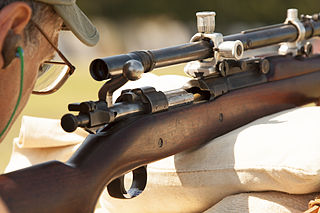
In firearms, the chamber is the cavity at the back end of a breechloader's barrel or cylinder, where the cartridge is inserted before being fired. The rear opening of the chamber is the breech, and is sealed by the breechblock or the bolt.

A gunsmith is a person who repairs, modifies, designs, or builds guns. The occupation differs from an armorer, who usually replaces only worn parts in standard firearms. Gunsmiths do modifications and changes to a firearm that may require a very high level of craftsmanship, requiring the skills of a top-level machinist, a very skilled woodworker, and even an engineer. Gunsmiths perform factory-level repairs and renovations to restore a well-used or deteriorated firearms to new condition. They may make alterations to adapt sporting guns to better fit the individual shooter that may require extensive modifications to the firearm's stocks and metal parts. Repairs and redesigns may require fabrication and fitting of unavailable parts and assemblies constructed by smiths themselves. Gunsmiths may also renew metal finishes or apply decorative carvings or engravings to guns. Many gun shops offer gunsmithing service on the premises.

The Vz. 50 is a Czechoslovakian made double-action, semi-automatic pistol. Vz is an abbreviation of the Czech term "vzor" meaning model.

Kerr's Patent Revolver was an unusual 5-shot single-action revolver manufactured from 1859 to 1866 by the London Armoury Company. It was used by Confederate cavalrymen during the U.S. Civil War. Seven of these revolvers were held by the New Zealand Colonial Defence Force in 1863 and were issued to the famous Forest Rangers at the start of the campaign to push Māori rebels out of the Auckland province. It is easily recognized by its side-mounted hammer.
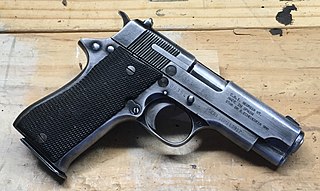
The Star Model BM is a single-action semi-automatic pistol that fires the 9 mm Parabellum pistol cartridge. It was produced by Star Bonifacio Echeverria, S.A. in Spain. Although its external appearance resembles the classic M1911, its design is different in several respects. For example, the Star does not have the 1911's grip safety. In addition, the thumb safety on the Star BM blocks the hammer, whereas it blocks the motion of the sear on a 1911 and the Star's trigger pivots on a roll pin rather than moving straight back like a 1911A1's trigger to trip the sear. The pistol is fed by an 8-round detachable box magazine.
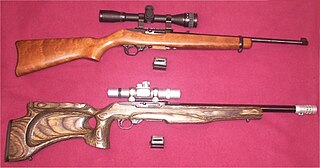
Firearm modification is commonly done in order to enhance various aspects of the performance of a firearm. Reasons for these modifications can range from cosmetic to functional, and can be simple operations that the owner can perform, or complex operations requiring the services of a gunsmith.
Microstamping is a proprietary ballistics identification technology. Microscopic markings are engraved onto the tip of the firing pin and onto the breech face of a firearm with a laser. When the gun is fired, these etchings are transferred to the primer by the firing pin and to the cartridge case head by the breech face, using the pressure created when a round is fired. After being fired, if the cases are recovered by police, the microscopic markings imprinted on the cartridges can then be examined by forensic ballistics experts to help trace the firearm to the last registered owner. A California law requiring the use of microstamping technology in all new semiautomatic firearms sold in the state has attracted controversy.

The Auto & Burglar Gun was a US-made factory-built handgun that was commercially manufactured by configuring a standard double-barrel shotgun with a pistol grip, at first engraving and later stamping "Auto & Burglar Gun" on each side of the frame, and shortening the barrels to about 10" to 12.2" in length.
The Winchester Model 21 is a deluxe side by side shotgun. The shotgun's initial production run from 1931 through 1960 yielded approximately 30,000 guns. Winchester Repeating Arms Company ceased the main production line of this shotgun in 1960 and the Model 21 was sourced to the Winchester Custom Shop until the gun's retirement in 1991. New Winchester Model 21 production continues under license to Connecticut Shotgun Manufacturing Company.

The Smith & Wesson Model 3 is a single-action, cartridge-firing, top-break revolver produced by Smith & Wesson (S&W) from around 1870 to 1915, and was recently again offered as a reproduction by Smith & Wesson and Uberti.

Short-barreled rifle broadly refers to any rifle with an unusually short barrel. The term carbine describes a production rifle with a reduced barrel length for easier handling in confined spaces. Concern about concealment for illegal purposes has encouraged regulations specifying minimum barrel lengths and overall lengths.

An antique firearm is a term to describe a firearm that was designed and manufactured prior to the beginning of the 20th century. Although the exact definition of what constitutes an "antique firearm" varies between countries, the advent of smokeless powder or the start of the Boer War are often used as cut-off dates. Antique firearms are usually collected because of their historical interest and/or their monetary value.
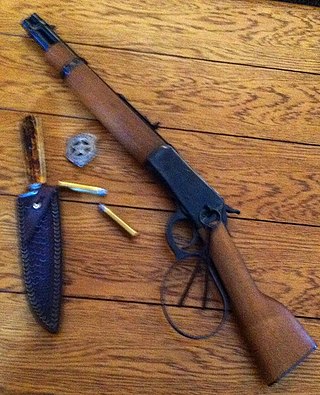
The Mare's Leg is the name given to a customized shortened rifle used by Steve McQueen's character on the television series Wanted: Dead or Alive (1958–1961). McQueen's character was named Josh Randall, and the gun has also been referred to as a Winchester Randall, or a Randall Special. Mare's Leg is now a generic term for a Winchester Model 1892 with a shortened barrel and stock.

Title II weapons, or NFA firearms, are designations of certain weapons under the United States National Firearms Act (NFA).
AB 1471 or AB 1471 Crime Gun Identification Act of 2007 is legislation passed by the California State Senate on September 6, 2007, and then by the California State Assembly on September 10, 2007, with votes of 21–17 and 43–29 respectively.
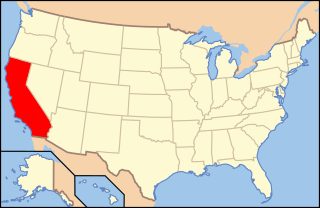
Gun laws in California regulate the sale, possession, and use of firearms and ammunition in the state of California in the United States.

Forensic firearm examination is the forensic process of examining the characteristics of firearms or bullets left behind at a crime scene. Specialists in this field try to link bullets to weapons and weapons to individuals. They can raise and record obliterated serial numbers in an attempt to find the registered owner of a weapon and look for fingerprints on a weapon and cartridges.


















